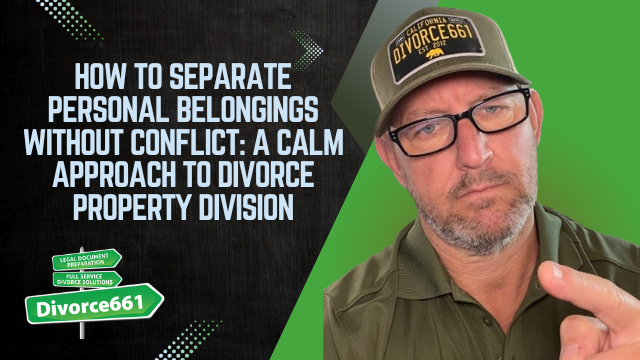How to Separate Personal Belongings Without Conflict: A Calm Approach to Divorce Property Division
Dividing personal belongings during a divorce can quickly become an emotional minefield. However, it doesn’t have to be that way. With the right mindset and strategies, you can navigate this challenging process peacefully and fairly. Drawing from practical experience and real client stories, this guide offers a calm, respectful approach to dividing household items, heirlooms, and sentimental keepsakes.
Setting the Tone: Why Calmness Matters
Divorce is inherently stressful, but turning the division of belongings into a battlefield only adds unnecessary tension. The key is to approach the process with a calm and respectful attitude. This helps foster understanding between both parties and reduces conflict. Remember, the goal is to divide fairly—not to “win” or prove a point.
Step 1: Create a Comprehensive List of Items
Start by listing all valuable or sentimental items that need to be divided. This inventory should include everything from furniture and electronics to family heirlooms and cherished photos. Having a clear list avoids surprises and disputes down the line.
Step 2: Use Fair Division Methods
One simple and effective method is the “you pick one, I pick one” approach. This technique encourages fairness by allowing each person to take turns choosing items. It ensures both parties feel involved in the process and reduces feelings of resentment.
Another way to divide belongings is by assigning items based on usage or sentimental value. For example, if one spouse used a particular piece of furniture more or has a stronger emotional connection to a keepsake, it makes sense for them to keep it.
Step 3: Avoid Fighting Over Low-Cost Items
It’s important to pick your battles wisely. Arguing over inexpensive items isn’t worth the stress and can escalate tensions unnecessarily. Focus on what truly matters to both parties and let go of the rest.
Handling Sentimental Items with Care
Sentimental belongings deserve special attention because their value often goes beyond money. Photos, keepsakes, and heirlooms carry memories that can be difficult to quantify.
- Digitize or Make Copies: Consider scanning photos or making duplicates of important documents and keepsakes. This allows both parties to preserve memories without conflict.
- Share or Rotate Heirlooms: For items like family heirlooms or children’s belongings, sharing or rotating possession can be a thoughtful solution that maintains family connections.
Real Client Example: Resolving Heirloom Disputes Fairly
One couple in Los Angeles faced a dispute over cherished family heirlooms. Instead of letting the conflict drag on, they agreed to credit one spouse with an equivalent value elsewhere in the property settlement. This balanced approach ensured both parties felt they were treated fairly and helped keep the process drama-free. It’s a powerful example of how compromise can lead to peaceful resolutions.
Recap: A Calm, Systematic Approach Works
- Begin with a complete list of belongings to avoid surprises.
- Use fair division techniques like “you pick one, I pick one” or assign items based on sentimental or practical value.
- Don’t waste energy fighting over low-cost items—focus on what truly matters.
- Handle sentimental items thoughtfully by digitizing, sharing, or rotating them.
- Be open to compromise, especially when it comes to heirlooms or emotionally charged possessions.
By adopting these strategies, you can minimize conflict and stress during an already difficult time. The goal is to move forward with clarity and respect, not to dwell on the past or create new tensions.
Need Help Dividing Personal Property After Divorce?
If you’re struggling with how to divide belongings peacefully, consider seeking professional guidance. Services like Divorce661 specialize in helping couples in California reach fair, amicable property divisions. With flat-fee divorce services and 100% remote support, Divorce661 offers clarity and peace of mind without the drama.
Visit Divorce661.com for a free consultation and take the first step toward a respectful and clear path forward.








